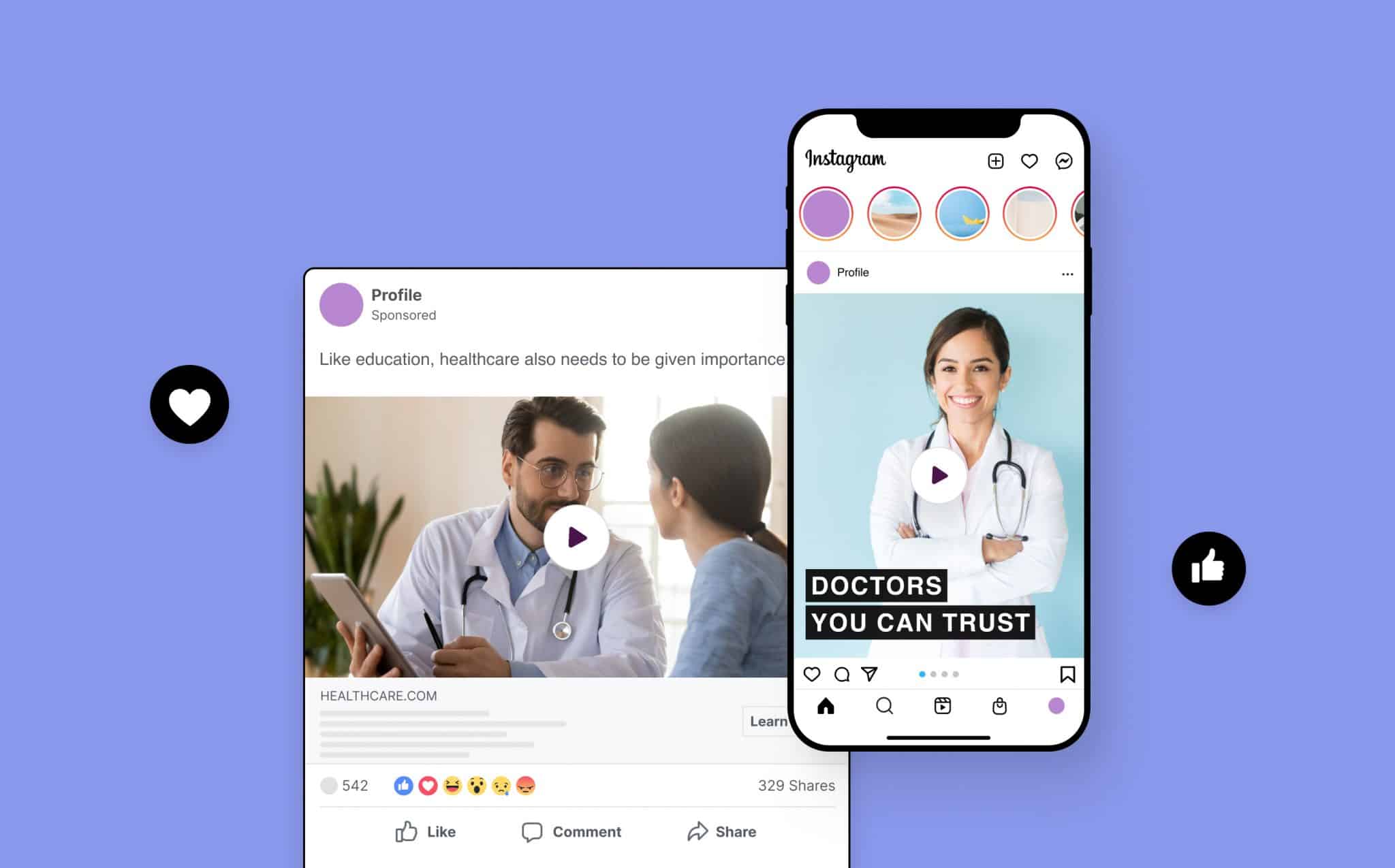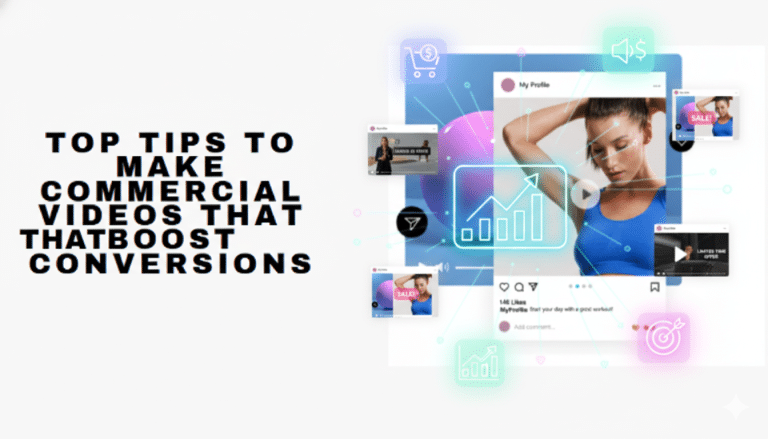
Healthcare Marketing: Top Strategies For Social Media and More

- Blog
- Video Marketing
- Healthcare Marketing: Top Strategies For Social Media and More
As healthcare providers, your first priority is offering exceptional care to help people live healthy lives. But in order to do that, you have to reach potential patients and make them know about your practice. Moreover, now that potential patients have so many options, you need more than ever to win them over. After all, how else will you stand out among the 784,626 healthcare companies in the U.S. alone? That’s where healthcare marketing comes in.
In this article, we’ll offer an in-depth guide to everything you need to know to market your healthcare practice – from why it matters to how you can do it successfully.

The Benefits of Healthcare Marketing
If you want to attract new patients (and we’re sure that you do), you are going to need to be proactive about promoting your brand and services on social media and the web.
These days, patients have many options to choose from when it comes to the clinics and providers they can visit. Differentiating yourself from your competitors is key to helping you stand out. Marketing is an effective way to show consumers how you are different from – and better than – the other healthcare options you are competing against.
Of course, a successful healthcare practice does more than just gain new patients; it must also retain its current patients. Healthcare marketing can help you connect to your patient community, building relationships that keep them coming loyally back to your practice in the long term throughout their life journeys.
Healthcare marketing through quality content also helps build trust. Trust is key in all consumer relationships – according to the 2019 Edelman Trust Barometer Special Report, 81% of consumers worldwide said they need to be able to trust the brands they buy from.
This is especially important in healthcare where providers are trusted with confidential information and dealing in something as sensitive and important as individuals’ well-being. Marketing can help you build a brand identity that reflects your values and abilities, teaching consumers to view you as a safe, trustworthy option.
Getting Started
If you’re brand new to marketing, there are a few steps we recommend taking to start out in building a successful, effective marketing strategy that helps you meet your practice’s larger goals.
1. Know or Build Your Practice’s Brand Identity
If you’re going to market a healthcare brand, it’s important that you know exactly what that brand is all about. Before you start implementing a marketing strategy, take the time to confirm you understand your brand’s identity. Ask yourself:
- What is my brand’s voice? Are we trustworthy and authoritative? Are we relatable and authentic?
- What are my brand’s values? What do we stand for?
- What is my brand’s visual identity? What colors, fonts, and logos do we use?
- What is my brand’s messaging? What slogans and mottos do we use?
If you’re not yet sure how to answer these questions, take some time to develop your brand identity before moving on to the next step.
2. Set Your Goals
Any strategic undertaking requires knowing what you want to achieve with your new project. Be sure to define your healthcare marketing goals, aiming to formulate goals that are as specific, measurable, time-bound, attainable, and relevant as possible. Ideally, your marketing goals will be tied to your practice’s KPIs or larger goals.
Some example goals to give you a jumping-off point for brainstorming include:
- Attract 35 new patients a month
- Achieve a patient satisfaction score of 7 or higher
- Reach 10,000 followers on Instagram
3. Choose a Healthcare Marketing Strategy
Once you know what goals you want to achieve with your healthcare marketing, it’s time to think about how you want to reach them. This step involves you considering the various healthcare marketing strategies and channels available to you and deciding which ones you think are a good fit for your business. Below, we outline a number of healthcare marketing strategies you can consider using for your practice. You can choose your marketing strategies on the basis of several factors, including:
- Your target audience
- Brand identity
- Budget
3. Determine Your Budget
Speaking of your budget, the next step is to determine how much money you want to and/or are willing to spend on healthcare marketing. You can create a sample budget as a jumping-off point that you will then present to stakeholders, who will help you finalize an approved marketing budget.
4. Track Your Data
The final step of implementing a healthcare marketing plan is deciding how you will track the success and progress of your marketing efforts. After all, the most strategic approach to marketing is one that uses data to determine what is working and what isn’t and then adjusting accordingly. The exact data you track will depend on the marketing strategies you choose to try out, but some options include:
- Social media followers
- Social media engagement (likes, comments, and shares)
- New patients
- Number of total monthly patients
- Brand recognition
Top Healthcare Marketing Strategies
Now let’s get into the best healthcare marketing strategies available that you can try out for your own practice. Below, we list a variety of marketing options that you might choose and offer suggestions for how to succeed with them.
Community Building
When it comes down to it, a healthcare provider is an incredibly important part of their community. They play a role in major life cycle events, keeping patients healthy so the community can thrive. That is why community-building is such an effective healthcare marketing strategy. By creating a sense of community within your practice, including physicians, staff, and patients alike, you can strengthen brand loyalty and retain your patients.
There are several options for community-focused marketing. These include:
- In-person – From hosting events such as food drives, charity fundraisers, and a healthy snack Easter egg hunt or trick-or-treating party to simply representing your practice with a booth at a local festival, getting out there into your community to meet people face-to-face and make real connections is a great way to find new patients.
- On social media – Social media is a great way to build community these days. Whether you choose to create a Facebook group for your community where members can chat directly with one another or simply take a community-focused approach to your social media accounts, interacting frequently with your followers, these networks are a great place to build and strengthen bonds.
- Direct communication – Community is all about relationships and showing your patients that you care about them. Taking steps as small as sending out birthday cards or even remembering to congratulate your patients on their anniversary or children’s graduations will help build your community through personal connections.
Websites that Work
Nearly three-quarters of Americans obtain health-related information from the internet, including information about the doctors they want to see and the clinics they want to visit. This means that your internet presence and website are incredibly important marketing tools. A good healthcare website will be easy to use and understand and clearly display important information patients will want to know, such as how they can contact you to make an appointment.
When setting up your practice’s website, keep the following considerations in mind.
Optimization for Different Formats
Today, people don’t only visit web pages on their desktop or laptop computers. They also view them on various mobile devices such as smartphones and tablets. Make sure that your website is optimized for all of these different formats and is equally easy to understand and read in all of them.
Fast Loading Speed
Modern consumers do not have the patience to wait for too long while a web page they are trying to visit loads. In fact, website conversion rates drop by an average of 4.42% with each additional second of load time. If your web page loads slowly, speak to your web admin to see what can be done to get those loading speeds up.
Accessibility
As important as it is for your clinic to be physically accessible to all people no matter with limitations they may have, it’s just as crucial for your website to be accessible to all, including those with visual and cognitive impairments, for example. An accessible website uses clear, easy-to-read fonts, has colors with sufficient contrast, includes video captions, and so on. For more information about how to create an accessible website, see the Web Accessibility Initiative’s website here.
Clear, Easy-to-Find Contact Information
Did you know that 71% of website visitors lose their trust when a healthcare website fails to deliver sufficient information? That’s why you want to make sure your contact information – such as your address, phone number, email address, booking portal, and navigation information – is easy to find and understand.
SEO Optimization
To help as many people as possible find your website and learn about your practice, you can implement search engine optimization practices that will make search engines like Google display your website more prominently when users search terms relevant to your site. There are many things you can do to improve your SEO, including:
- Identifying keywords you want to rank for and using them naturally throughout your website’s content, meta descriptions, headers, URLs, image alt texts, and more
- Linking to pages from your and other websites
- Having a clear, logical website structure
- Keeping your content fresh by regularly updating it
SEO is a world of its own and involves a lot of elements, but your web designer should be able to help you optimize your website.
Video Marketing
One of the most effective marketing strategies available to healthcare professionals is video. Studies show that 54% of consumers want to see more video content from a brand or business they support, and 72% of customers report that they would rather learn about a product or service through the video format. That’s probably why 86% of businesses use video as a marketing tool — up from 63% over the last three years.
One of the best parts of video marketing is that it allows you to be so creative. But that can also be a double-edged sword: sometimes it’s difficult to come up with new ideas for fresh video content. That’s why we’re here to help you out with a list of options for different types of healthcare marketing videos you can create.
Physician Profiles
One of the most unique benefits of video over other content formats is its ability to make emotional, personal connections. Creating videos profiling various physicians at your practice is a great way to make current and potential patients feel more comfortable with them. Keep these videos short and sweet, just a minute or two having the physician introduce themselves, their background, and the area they practice in, as well as a few fun facts that viewers might be able to relate to.
A simple physician profile might have a script as simple as, “Hi, I’m Dr. Nina Lopez and I’ve been an OBGYN here at XYZ Medical for the past eight years. In my spare time, I love to go backpacking and visit the dog park with my best friend, Toby.”
Health Tips
As healthcare providers, your audience looks to you as an authority about all things related to health and wellness. To help grow your brand as authoritative, knowledgeable thought leaders in the healthcare industry, you can create short videos sharing health tips for your patients.
Patient Testimonials
As you’ll read later on in this article, recommendations from others are an incredibly powerful motivator for patients in terms of which doctors and clinics they choose to visit. This means that patient testimonial videos are an incredibly effective healthcare marketing tool.
There are a couple of ways to approach creating this type of video. One is to have a patient directly share their story by speaking to the camera. And another is to have a slideshow sharing quotes from multiple patients. In fact, both types of videos are great to have on your website and social media pages.
Staff Spotlights
Of course, physicians aren’t the only people your patients will interact with when they visit your practice. Staff members are the heart of any healthcare organization and they can make a big impact on patients’ impression of your brand. Making staff spotlight videos introducing your audience to your staff can help build a sense of community. If your patients come in already feeling like they’ve met your staff ahead of time, they’re certain to feel that much more comfortable in your office.
There are a number of ways to make staff spotlight videos. One of our favorites is creating a slideshow with photos of each office staff member, their name, their role in the office, and a fun fact about them. If it fits your brand, you can even take silly photos of each staff member to make the audience feel at ease with them.
Patient Stories
Healthcare organizations are changing lives every day, and the stories of the people on whom you’ve made a positive impact are one of the most powerful marketing tools that you have. Think about the patients whose stories have been the most inspiring. Maybe it’s the baby that one of your OBGYNs helped deliver for a mother whose birth they assisted on decades ago. Maybe it’s the pediatric patient who stayed strong all through the process of being diagnosed with diabetes.
Whatever the stories might be, creating videos in which patients share what they have been through can have an uplifting impact on your audience and help create positive associations with your brand.
Promo tip: Promo offers a royalty-free music library with pre-approved music you can use in your videos. Try searching key terms like “inspiring” and “motivational” for music that will perfectly accompany patient story videos.
Services Showcase
An important piece of information that prospective patients will want to know about your practice is what services you offer and in which areas your physicians practice. An informative video listing all of the services you have available can be a great marketing tool for helping your organization reach the right patients. Your services showcase video can be in the slideshow format, as simple as a series of photos with text.
Promo tip: Promo’s video maker allows you to add custom branding such as logos, watermarks, and colors so that your services showcase video is easily tied to your organization.
Facility Tours
Have a state-of-the-art facility that you’re proud of and view as a selling point for your practice? Consider creating a video touring around the facility so potential patients can see just how clean, modern, and welcoming your offices are. This video can either be a filmed video tour or even just a photo slideshow with pictures taken around your facilities. Add some lively music in the background to keep it interesting and you’ve got a great marketing video.
SEO Content Marketing
Did you know that 70,000 healthcare searches are performed every minute? That’s why another type of marketing that is incredibly popular these days is SEO content marketing. Plus, it’s quite effective: companies with blog posts produce, on average, 67% more leads per month.
SEO content marketing strategy involves creating content, most often in the form of written blog articles, about certain keywords that you want to rank for. Rather than directly marketing your practice, these articles will instead aim to provide value for readers. The more valuable your articles are, the higher they will rank on search engines and the more visitors you’ll attract to your website. Once they’re there, you’ll be able to try to encourage them to become a patient.
Let’s say, for example, that you run a dermatology practice. Through SEO research, you might find that some of the keywords people are searching for related to dermatology include:
- Skin tag removal
- Can skin cancer look like a pimple
- Does skin absorb water
With this information, you can plan to create SEO-optimized articles related to each of these keywords. If you do a good job, your articles might be displayed prominently on search engines, helping new people find your website.
Email Marketing
In the age of TikTok and text messages, email marketing can feel a little old-fashioned, but it’s still incredibly effective. In fact, it might even be slightly more favorable for healthcare than other industries: the average email open rate for the healthcare industry is 21.48% and the average click-through rate for healthcare email marketing is 2.69%, compared to 21.33% and 2.62% in other industries.
Still not convinced? You should know that email marketing has an ROI of up to $36 for every $1 invested.
To succeed in email marketing, you’ll need to begin by putting together a mailing list of email addresses. You can capture email addresses in a multitude of ways including patient intake forms, newsletter signup forms on your website, and by creating valuable content that you only make available to people if they give you their contact information.
Once you have an email list, it’s a matter of sending relevant, well-crafted emails. There are a number of best practices it is recommended to follow when it comes to email marketing, including:
- Crafting catchy subject lines
- Personalizing emails with patient information like their names in the greeting
- Including visual elements and avoiding large chunks of text
- Using calls-to-action (CTAs) asking patients to perform an action such as book an appointment
- Including branding
- Keeping it concise
Reviews and Ratings
One final marketing strategy to consider is managing your online reviews and ratings. After all, 59% of Americans find patient reviews to be very important or somewhat important when choosing a physician.
The reason why reviews and ratings are so important comes down to a psychological concept called social proof. As social animals, humans have a tendency to look to one another for cues as to how to behave. In short, we trust other people to tell us what we should do, what we should buy, and which healthcare practitioners we should see.
Review management involves a few things. First, you should encourage your patients to leave positive reviews for you whenever possible. These reviews live on your website as well as on websites like Yelp, Facebook, and Google. If you do see anybody has left a negative review for you, follow up on it. It will show your audience that you are diligent and look to address any issues that patients may have had. And finally, give your patients incentive to recommend you to their friends and family either through word of mouth or online. A patient referral program is a great idea to consider.
Wrapping Up
Healthcare is one of the largest industries in the world with billions of dollars in revenue every year. Building and executing a healthcare marketing strategy is one of the best ways to gain a competitive advantage and market share in the field, allowing you to reach more patients and, ultimately, help more people live longer, happier, healthier lives. This article offers a variety of healthcare marketing strategies you can use to get there. Now it’s just a matter of getting started.
Boost Your Business
Choose tailored footage from over 110M+ photos and videos for your video projects. Brand and share online in minutes.
About the author
Daisy Rogozinsky
Daisy Rogozinsky loves to use the written word to educate, entertain, and tell stories. If she's not writing content, she's writing poetry, music, and screenplays.


